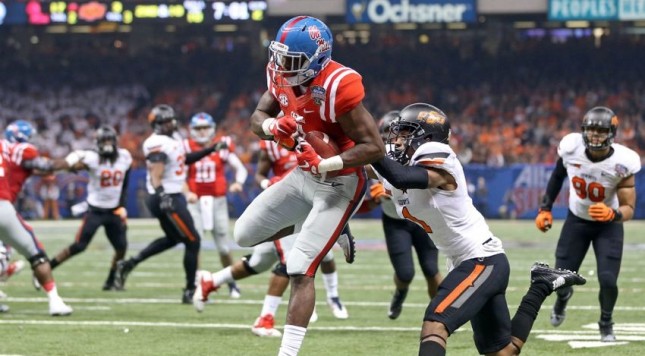The Big 12’s now-completed college football season is a trail of regret, littered with irony and aches and a sense of unfulfilled promise… even though the conference achieved its absolutely necessary goal of making the College Football Playoff.
After the TCU-and-Baylor snub of 2014, the Big 12 had to make the playoff in 2015. The Oklahoma Sooners achieved that goal, so regardless of what else you might want to say about the Big 12 this past season, it certainly wasn’t a total waste. Making the playoff will enable Bob Bowlsby to sleep a little more peacefully in the coming months. (Getting at least Kansas or Oklahoma in the basketball Final Four is the next big goal.)
Yet, despite the attainment of playoff relevance and centrality, the Big 12’s overall season — reinforced by the bowls — was a journey marked by regrettable occurrences. Let’s dispense with the elaborate prelude and dive right in.
Had Oklahoma beaten Texas, it would have been the No. 1 team in the College Football Playoff and drawn a Michigan State side whose offense was clearly not ready for prime time. However, the Sooners stumbled against the Longhorns and had to draw Clemson in Miami. Clemson’s offense did leave points on the field, but the Tigers were certainly potent enough to force OU’s offense to be great. Once again, a talented Sooner quarterback took the field for Bob Stoops in a championship-stage game and failed to score 20 points, continuing a pattern which began in the 2001 Orange Bowl with Josh Heupel. Baker Mayfield couldn’t do what Heupel, Jason White, and Sam Bradford also failed to achieve. Oklahoma won’t win another national title until its offense is able to play a complete game when it really matters.
The trail of regret is just beginning to come into view. Texas, a team unable to make a bowl game, created another headache for the league when it beat Baylor in the regular season finale.
Had Baylor beaten Texas, it would have headed to the Sugar Bowl to play Ole Miss. Based on everything we saw from Art Briles in the Russell Athletic Bowl against North Carolina, the Bears stood a good chance of winning that game and striking a blow for the Big 12. Instead, an inferior Oklahoma State team went to New Orleans and got its clock cleaned by the Rebels, which made the Big 12 look really bad.
Losing to Texas: It’s not a good idea. Yet, two of the Big 12’s more accomplished programs — the two favorites in 2016, as a matter of fact — both did so. That’s regrettable.
Much of the Big 12 — having seen how Oklahoma State got wiped off the map by Ole Miss — should be regretting its inability to beat Oklahoma State when it had the chance.
Kansas State. Iowa State. Texas Tech. Texas. West Virginia. These teams either led OSU by at least 13 points or were tied with the Cowboys inside the five-minute mark of regulation or later. None of them could win. Given that Oklahoma State’s three losses were blowouts (Baylor, OU, Ole Miss), the Cowboys are a lot like a Northwestern team which similarly suffered lopsided defeats (Iowa, Michigan, Tennessee in the Outback Bowl). It’s OSU which should have played North Carolina in the Russell Athletic Bowl, but the Big 12’s collective inability to do so is what reshaped the bowl matchups in ways that were unfavorable to the conference.
The Big 12 season, beyond the bowls, witnessed painful changes for the programs in the middle tier of the conference. Kansas State lost multiple games in which it led at halftime, snapping a longstanding streak just short of the 50-game mark. Texas Tech lost two games in which it scored at least 52 points. West Virginia had to endure its difficult schedule rotation (roadies at OU, TCU, Baylor, and Kansas State) after a favorable 2014 rotation. The high-end teams need to do more in big games and in the bowl season, but the conference’s larger identity in 2016 will be shaped by the KSU-WVU-Texas Tech trio. If these programs can rise, the Big 12 will have a lot more quality to point to.
For now, though, the Big 12 exists in the land of “What if?” Too many almosts and might-have-beens litter the landscape as this conference wonders how it can improve in the season to come.

